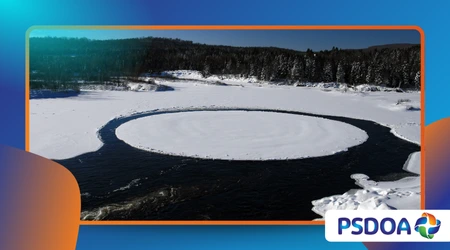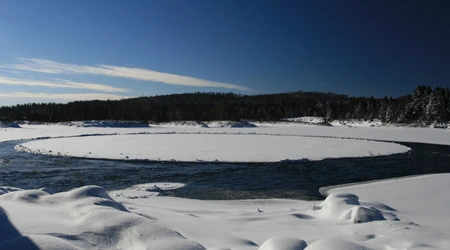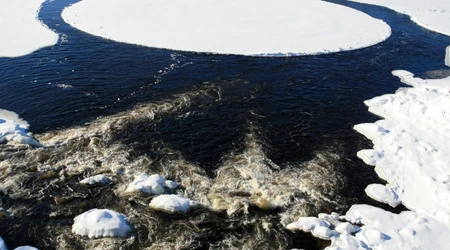Círculos de hielo: esculturas giratorias de la naturaleza en ríos helados

Círculos de hielo, esas fascinantes obras de arte naturales, cautivan a los espectadores con su serena rotación en ríos helados.
Anuncios
Estas raras formaciones, esculpidas por la delicada mano de la naturaleza, emergen en condiciones precisas, combinando dinámica de fluidos, termodinámica y armonía ambiental.
Se encuentran en cursos de agua de clima frío, como el lago Baikal en Siberia o el río Presumpscot en Maine, y despiertan curiosidad entre científicos, fotógrafos y entusiastas de la naturaleza.
Este artículo profundiza en la ciencia, la belleza y el significado cultural de círculos de hielo, explorando su formación, avistamientos globales y por qué son importantes en la narrativa ambiental de 2025.
Los cambios climáticos alteran los ecosistemas fluviales y comprender estos fenómenos ofrece información sobre la resiliencia y la fragilidad de la naturaleza.
Anuncios
La ciencia detrás de los círculos de hielo
En ríos helados, círculos de hielo Se forman cuando corrientes lentas se encuentran con temperaturas gélidas. Un suave remolino, o corriente circular, recoge fragmentos de hielo formando una estera giratoria.
La fricción suaviza los bordes, creando discos casi perfectos. Según un estudio de 2019 de la Sociedad Meteorológica Americana, las corrientes de agua en lechos de ríos poco profundos impulsan este proceso. La interacción entre la velocidad y la temperatura da forma a estas esculturas.
Este fenómeno depende de condiciones precisas. El agua debe fluir lentamente, a menudo formando recodos o charcas, para formar remolinos. Las temperaturas bajo cero congelan el agua superficial, formando los primeros trozos de hielo.
++ El destello verde: una ilusión óptica de una fracción de segundo al atardecer
Estos trozos chocan, deshaciéndose en formas circulares. El resultado es un disco giratorio, a veces de varios metros de ancho, que flota con gracia.
Los científicos se maravillan ante la dinámica de fluidos en juego. Los remolinos actúan como tornos naturales, refinando el hielo irregular hasta convertirlo en hielo liso. círculos de hielo.
Este proceso imita al de un alfarero moldeando arcilla, pero las herramientas de la naturaleza son el agua y el frío. Cada disco refleja los patrones únicos de flujo del río, lo que hace que cada círculo sea único.

Dónde presenciar círculos de hielo
Círculos de hielo Aparecen en regiones frías con ríos de curso lento. Escandinavia, Canadá y el norte de Estados Unidos albergan estos espectáculos.
El lago Baikal en Siberia, declarado Patrimonio de la Humanidad por la UNESCO, es un punto crítico, con discos de hasta 4 metros de ancho reportados en 2025. El río Presumpscot de Maine también ganó fama después de que un avistamiento en 2019 atrajera a miles de personas.
El cambio climático afecta su frecuencia. Los inviernos más cálidos reducen la formación de hielo, lo que hace que... círculos de hielo Más raro. Sin embargo, en climas fríos estables, los avistamientos persisten.
Por ejemplo, un informe de 2024 del río Yukón, en Canadá, detectó un disco de 3 metros, fotografiado por lugareños. Estos lugares ofrecen excelentes oportunidades de observación.
Lea también: Nubes de gloria matutina: las serpientes ondulantes del cielo
Los fotógrafos acuden en masa para capturar su brillo etéreo. La luz del atardecer realza su brillo, creando imágenes impactantes.
Viajeros que buscan círculos de hielo Deberíamos centrarnos en los meses de invierno en las latitudes septentrionales, pero las tendencias de calentamiento exigen urgencia. ¿Perderemos estas maravillas por el aumento de las temperaturas?
Importancia cultural y simbólica
Más allá de la ciencia, círculos de hielo Tienen un gran peso cultural. Las comunidades indígenas de Siberia las consideran símbolos de armonía, que reflejan el equilibrio cíclico de la naturaleza.
Sus formas perfectas inspiran asombro, a menudo vinculadas a narrativas espirituales sobre el agua y la renovación. En los medios modernos, simbolizan el arte de la naturaleza.
Los artistas se inspiran en su forma. Una exposición de 2025 en Oslo presentó esculturas inspiradas en círculos de hielo, que fusionaban hielo y luz para imitar su brillo.
Las redes sociales amplifican su atractivo, con hashtags como #IceCircle que serán tendencia en plataformas como X en enero de 2025.
Leer más: Brinicles: Los carámbanos submarinos mortales que se forman bajo las plataformas de hielo
Su rareza despierta fascinación. A diferencia de los copos de nieve comunes, círculos de hielo exigen condiciones específicas, haciendo de cada avistamiento un regalo fugaz.
Nos recuerdan la capacidad de la naturaleza para crear belleza en entornos hostiles, lo que provoca una reflexión sobre el delicado equilibrio de nuestro planeta.
Perspectivas ambientales y conexiones climáticas
Círculos de hielo Revelan verdades ambientales. Su formación depende de climas fríos estables, amenazados por el cambio climático.
Un informe de 2025 del Centro Nacional de Datos de Nieve y Hielo señaló una disminución de 15% en la capa de hielo de los ríos desde el año 2000. Esto afecta círculo de hielo formación, lo que indica cambios ecológicos más amplios.
Estas formaciones también resaltan el papel de la dinámica de fluidos en los ecosistemas. Ríos con círculos de hielo A menudo sustentan una biodiversidad única, ya que las corrientes lentas crean hábitats para la vida acuática.
Su disminución podría perturbar estos ecosistemas y afectar a especies como el salmón o las nutrias de río.
Los conservacionistas utilizan círculos de hielo Para defender la protección de los ríos. En 2025, las campañas en Canadá hicieron hincapié en la preservación de los hábitats de aguas frías para mantener estos fenómenos.
Su belleza sirve como un llamado a la acción, instándonos a combatir el cambio climático y proteger las maravillas naturales.
Cómo capturar círculos de hielo: consejos para fotógrafos

Fotografiando círculos de hielo Requiere paciencia y habilidad. La luz del atardecer o del anochecer crea un efecto brillante, ideal para capturar su belleza.
Una guía de fotografía de 2025 de National Geographic recomienda utilizar filtros polarizadores para reducir el resplandor y mejorar el contraste.
Los trípodes garantizan la estabilidad en tomas de larga exposición, revelando la lenta rotación del disco. Los drones ofrecen perspectivas aéreas, mostrando su escala en contraste con los paisajes fluviales.
Por ejemplo, en 2024 un fotógrafo de Yukon utilizó un dron para capturar un disco giratorio, lo que le valió reconocimiento mundial.
Los aficionados pueden tener éxito con un equipo básico. Un teléfono inteligente con ajustes manuales puede capturar imágenes impresionantes si se usa en el momento oportuno.
Concéntrese en encuadrar el círculo contra la corriente del río, enfatizando su movimiento. Estos consejos hacen círculos de hielo accesible a todos los fotógrafos.
Tabla: Ubicaciones clave para avistamientos de círculos de hielo (2025)
| Ubicación | País | Características notables | Mejor horario de visualización |
|---|---|---|---|
| Lago Baikal | Rusia | Discos grandes, de hasta 4 m, sitio de la UNESCO | Enero–marzo |
| Río Presumpscot | EE.UU | Avistamiento famoso de 2019, accesible | Diciembre-febrero |
| Río Yukón | Canadá | Se reportan discos remotos, prístinos, de 3 m | Enero-febrero |
| Río Esrum | Dinamarca | Discos más pequeños, entornos pintorescos. | Enero–marzo |
Círculos de hielo en la era de las redes sociales
La naturaleza viral de círculos de hielo explotó en 2025. Una publicación en X de Bashkiria, Rusia, que mostraba un disco del río Betra, obtuvo 10,000 compartidos.
Esta visibilidad impulsa el turismo, pero conlleva el riesgo de generar daños ambientales. Las comunidades locales instan a realizar visitas respetuosas.
Ejemplo: En enero de 2025, un excursionista de Maine compartió un video de un disco giratorio, con el título: "¡El carrusel de la naturaleza!". Esto despertó interés mundial y los fotógrafos acudieron en masa al sitio.
Esto muestra cómo las plataformas digitales amplifican los fenómenos naturales, creando tanto oportunidades como responsabilidad.
Otro ejemplo: Un artista canadiense publicó un time-lapse de un Yukón círculo de hielo, mezclándolo con música para evocar asombro.
Se compartió ampliamente e inspiró debates ambientales. Las redes sociales transforman círculos de hielo en las conversaciones globales, pero el turismo sostenible es clave.
Un llamado a preservar el arte de la naturaleza
Círculos de hielo Son más que curiosidades; son indicadores de la salud ambiental. Su dependencia de ríos fríos y estables los hace vulnerables al cambio climático.
Proteger estas formaciones significa salvaguardar los ecosistemas fluviales, que sustentan una vida diversa.
En 2025, los grupos de defensa enfatizan la conservación de los ríos. Por ejemplo, una iniciativa siberiana busca reducir la escorrentía industrial hacia el lago Baikal, preservando así su fenómeno de hielo. Apoyar estos esfuerzos garantiza que las generaciones futuras sean testigos de... círculos de hielo.
Imagina un mundo donde círculos de hielo Desaparecerían, como melodías olvidadas del invierno. Su pérdida indicaría un daño ecológico más profundo. Si actuamos ahora, reduciendo las emisiones y apoyando la conservación, podremos preservar estas esculturas giratorias durante años.
Preguntas frecuentes
¿Qué causa la formación de círculos de hielo?
Las corrientes lentas de los ríos y las temperaturas bajo cero crean remolinos que dan forma a los fragmentos de hielo en discos circulares giratorios, suavizados por la fricción.
¿Dónde puedo ver círculos de hielo en 2025?
Los lugares privilegiados incluyen el lago Baikal (Rusia), el río Presumpscot (EE. UU.), el río Yukón (Canadá) y el río Esrum (Dinamarca) durante los meses de invierno.
¿Los círculos de hielo se ven afectados por el cambio climático?
Sí, los inviernos más cálidos reducen la capa de hielo de los ríos, disminuyendo así la formación de círculos de hielo, como se señala en un informe del Centro Nacional de Datos de Nieve y Hielo de 2025.
¿Cómo pueden los fotógrafos capturar círculos de hielo de manera efectiva?
Utilice filtros polarizadores, trípodes o drones a última hora de la tarde para resaltar su brillo y movimiento, según la guía 2025 de National Geographic.
¿Por qué los círculos de hielo son culturalmente significativos?
Los grupos indígenas los ven como símbolos de armonía, mientras que los artistas modernos y los usuarios de las redes sociales celebran su rara belleza natural.
Esta exploración de círculos de hielo Combina ciencia, cultura y urgencia medioambiental, ofreciendo una ventana al arte de la naturaleza.
Mientras nos maravillamos de su belleza, comprometámonos a preservar los frágiles ecosistemas que las crean.
